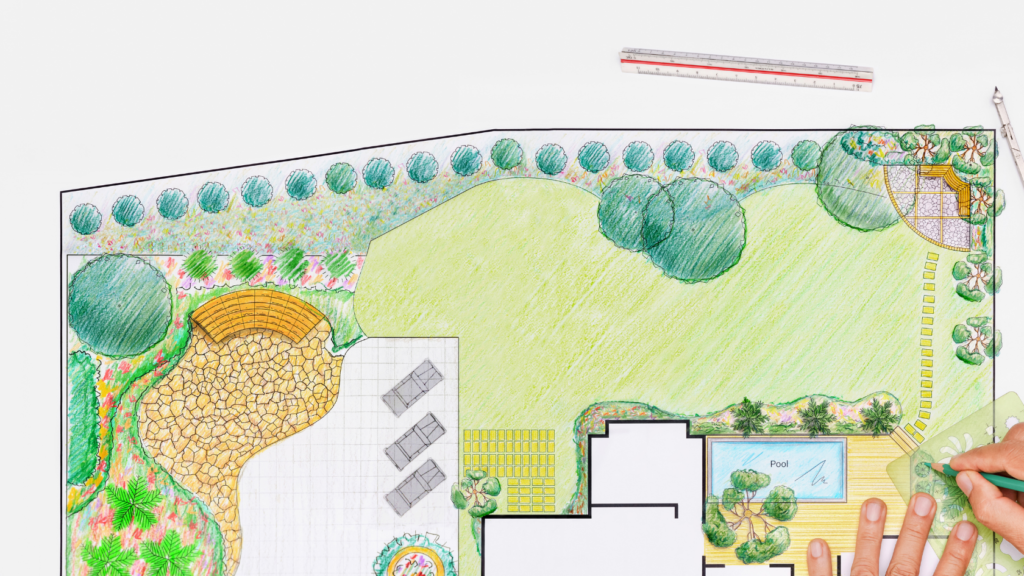The Complete Step-by-Step Guide to Design a Sprinkler System

- Creating Your Sprinkler System Plan
- Choosing Your Sprinkler Heads
- Installing the Main Line
- Programming the Timer
- Final System Adjustments
- When to Consider Professional Help
- Winterizing Your System
- Ongoing System Maintenance
- Tackling Sprinkler Repairs
- Choosing Quality Components
- Where to Purchase Sprinkler Equipment
If you’re eager to get that beautiful, lush lawn and vibrant garden, installing a sprinkler system is the way to go. With proper hydration that a sprinkler system provides, you’ll get to enjoy your yard instead of spending all your time hand watering.
But between picking out sprinkler heads and piping, measuring your yard, zoning things off, and actually installing it, designing a sprinkler system for the first time can definitely seem daunting. Have no fear though! In this detailed guide, you’ll learn everything you need to plan and install your first sprinkler system like a pro.
We’ll cover things like:
– Important planning steps before purchasing anything
– Recommended tools and materials to get
– Measuring and mapping your yard
– Design principles for creating efficient irrigation zones
– Types of sprinkler heads and which work best where
– Installing the piping, valves, timers, and heads
– Programming timers and adjusting the system
– Winterizing and maintenance
Even if you have zero prior experience with irrigation, you’ll finish this guide with the knowledge to create a beautiful customized sprinkler system that waters your yard perfectly. Let’s get started!
Creating Your Sprinkler System Plan
The very first step is proper planning even before you buy your first part. This prevents wasting money on the wrong materials or creating issues down the road.
Inspect Your Yard
Walk around your yard and make note of things like:
– Specific areas that need more or less water (lawns vs flower beds)
– Slopes or uneven ground
– Shaded zones under trees
– Soil type in each section
– Where sprinklers will need to spray and not spray (sidewalks, walls)
This allows you to divide areas into zones with similar needs.
Determine Water Source
Figure out where you’ll connect the main line and test the water pressure from any spigots using a pressure gauge. Ideal pressure is 45-70 PSI. Also measure flow rate by timing how fast it takes to fill a 5 gallon bucket.
Check Local Building Codes
Call your city office to learn about permits, regulations, and buried utility marking requirements before digging trenches.
Pick Equipment and Parts
Do some research on types of sprinkler heads, timers, valves, piping etc. This will help you create a “wish list” for your system. Check out this post for tips on choosing the correct sprinkler head type for your system.
Measure and Map Your Yard
Accurately measuring your entire yard helps you calculate how much equipment you’ll need. Create a scaled map showing dimensions, planting areas, and obstructions.
Use these plans to imagine potential sprinkler layouts and irrigation zones.
Must-Have Tools and Materials
Here are some tools and materials you’ll want to have on hand for installing your sprinkler system:
Tools:
– Shovel and pickaxe – digging trenches
– Rake – smoothing soil
– PVC cutter – cutting pipes
– Hacksaw – cutting pipes in tight spots
– Teflon tape – sealing pipe threads
– PVC glue and primer
– Wire strippers
– Trencher rental – nice for quick trench digging!
Materials:
– PVC pipe – main line and lateral line piping
– Sprinkler valves – control water to zones
– Sprinkler heads – distribute water
– Backflow preventer – stops contaminated water flowing back into home supply
– PVC fittings – elbows, tees, couplers to connect pipes and heads
– Control wire – low voltage wiring connecting valves to timer
– Sprinkler timer – to control watering schedules
Choosing Your Sprinkler Heads
Two main types of sprinkler heads to consider are spray heads and rotor heads.
Spray Heads:
– Best for small to medium areas
– Release a fan pattern spray in a fixed arc
– Affordable and adjustable
Rotor Heads:
– Designed for larger areas
– Rotate and distribute water in a circular pattern
– Allow adjustment of spray distance and angles
– More expensive but very efficient
You’ll also need to pick nozzles that match your water pressure and precipitation rate. Consider specialized heads for slopes, odd shapes, or gardens.
Recommended Brands: Hunter, Rain Bird, Orbit, Toro
Check out this post for tips on choosing the correct sprinkler head type for your system.
Determining Valves and Timer
Control valves turn water to each zone on and off. Choose durable, compatible valves rated for your water pressure.
The timer or controller is the brains telling the valves when to activate. Pick an automatic multi-zone timer allowing custom schedules per zone.
Installing the Main Line
The main PVC line delivers water from the supply source to the valves and sprinkler zones.
Steps to install:
- Lay out planned path for main line across yard.
- Dig a trench at least 18 inches deep along the path using your shovel or trencher.
- Begin joining PVC sections with proper primer and glue for secure watertight joints.
- Place control valves along the main line where planned.
- Install backflow preventer near water source per local code.
- Connect timer to valves and power source.
- Open supply and pressurize main line. Inspect for leaks at all joints and fittings.
Running Lateral Lines and Installing Heads
Lateral lines carry water from the valves to each zone’s sprinkler heads.
- Lay out planned lateral line runs using diagrams as a guide.
- Dig trenches approximately 8 inches deep for laterals.
- Cut sections of PVC and assemble with fittings to connect heads.
- Securely glue fittings and allow time to cure before backfilling trenches.
- Flush debris from lines using a hose on full blast.
- Screw in sprinkler heads with care along laterals using Teflon tape. Ensure tight seal.
- Open valves one zone at a time and test coverage, adjusting watering radius and range as needed.
- Address any leaks or adjustments before burying lines!
Programming the Timer
The timer activates each zone’s preset schedule. Setting cycle times tailored to your landscape ensures efficient watering.
– Enter current date/time so schedules run when expected.
– Set individual zone run times based on plant type, sun exposure, soil etc.
– Schedule zone start times to prevent overlapping.
– Adjust for weather and season.
– Check controller manual for all programming options and capabilities.
Final System Adjustments
Run the system and make any final tweaks:
– Redirect or adjust heads for even coverage and to avoid spraying on walls, fences, etc.
– Check for dry spots and add heads as needed.
– Confirm proper drainage – no pooling or runoff.
– Adjust zone schedules based on real world testing and observation of your yard soil and plants.
Be patient – it takes some trial and error to dial in the perfect watering schedule. But the rewards of seeing your sprinkler system spring to life are worth it!
Consider Professional Help
If your yard has complex landscaping, slopes, or drainage issues, consider hiring a pro. While it costs more, you get the assurance of an expert design and installation.
Professionals also have specialized tools that make installations much quicker and easier compared to DIY. Get in touch with reputable irrigation specialists in your area to discuss your project.
Winterizing Your System
In freezing climates, winterize to avoid catastrophic damage:
– Have pros use compressed air blowouts to remove all water from lines.
– Manually open drains and bleed valves, remove heads, drain pipes.
– Disconnect and store above-ground components like timers.
– Insulate any components that can’t be fully drained.
– In spring, gradually reactivate the system and check for needed repairs from winter.
Check out this post for tips on sprinkler winterization costs and a free DIY winterization checklist.
Ongoing System Maintenance
Regular maintenance keeps your system working flawlessly:
– Inspect components yearly for needed repairs or replacement.
– Adjust watering times and schedules seasonally based on weather.
– Monitor water usage on your bill to quickly detect abnormal spikes indicating leaks.
– Clean and flush debris from sprinkler heads before storing for winter.
– Lubricate and replace worn seals and gaskets on valves preventatively.
By staying on top of maintenance and observing performance, you can enjoy your perfectly watered yard for years to come!
Tackling Sprinkler Repairs
Even properly installed systems can develop issues. Try these troubleshooting tips:
Constant leaking/flooding – Immediately shut off main water supply and determine cause. May require pro help for major leaks or pipe damage.
Zone won’t activate – Check timer, wiring connections, and solenoid. Replace damaged solenoid if not engaging.
Low pressure – Examine supply for clogs. Consider adding a booster pump if pressure drop is chronic.
Broken sprinkler heads – Replace damaged nozzles, stems, and internals promptly to avoid improper spraying.
Pools of water – Adjust zone time downward. Improve drainage or change to low angle nozzles.
Dry spots – Check for clogs and add/reposition heads to fill in water gaps. May need head on opposing side.
Uneven watering – Adjust spray pattern on nozzles. Clean clogged debris screens. Ensure equal pressure at each head.
By methodically isolating issues and making repairs, you can keep your system operating like new.
Check out these posts for more maintenance tips:
How to Stop a Sprinkler Leak Fast
Fixing Most Common Sprinkler Problems
Sprinkler Maintenace Tips for a Healthy Lawn
Choosing Quality Components
Purchasing quality parts from reliable brands ensures longevity and performance.
Recommended Brands:
– Hunter
– Rain Bird
– Orbit
Purchase Considerations:
– Durability for longevity against elements
– Precision water distribution
– Easy to adjust and maintain
– Noise level on rotating sprinklers
– Cost of replacement parts
While quality parts cost more upfront, the investment is worth it for long-term functionality and water savings from precision watering.
Where to Purchase Sprinkler Equipment
You have several options to purchase equipment for your sprinkler project:
– Home Depot/Lowes – Convenient but limited selection. Staff have basic knowledge.
– Hardware stores – Some have an irrigation section seasonally. Quality varies.
– Irrigation specialty suppliers – Offer extensive selection and expert advice, but limited locations.
– Direct from manufacturers – Order direct from brand websites like Hunter or Rainbird.
– Online specialty retailers – Sites like Sprinkler Warehouse or Irrigation Direct offer wide variety with knowledgeable support.
– Amazon – Very broad selection but lack of expert guidance. Focus on reputable brands.
Talk to the pros at specialty irrigation stores – their expertise will ensure you purchase components ideally suited for your yard and conditions.
Installing a sprinkler system is very manageable for the DIYer if you take time to properly plan and select quality components. Divide your landscape into zones based on plant and terrain needs. Invest in durable, high-performing parts from leading brands to achieve water efficiency. And don’t be afraid to call in the experts if your situation calls for it. With the right guidance, you’ll have your yard hydrated perfectly in no time!
As an Amazon Associate, we earn from qualifying purchases. Affiliate links help support our work and allow us to continue providing free content. If you make a purchase through an affiliate link, we receive a small percentage of the sale at no extra cost to you.
The DIY repair advice on this site is for informational purposes only. The content aims to be helpful but cannot guarantee success or substitute professional advice. Any repairs involve some risk, so readers assume all liability and responsibility for their actions. Safety should be the top priority. If unsure about any procedure, first consult a qualified professional to determine suitability.
- Sprinkler Rebate Guide
- Slash Your Water Bill and Save the Planet with Sprinkler Rain Sensors!
- How to Revive a Lawn: Bringing Your Drought-Stricken Lawn Back to Life
- Sprinkler Repair Costs: The Shocking Truths You Need to Know!
- Gardeners Won’t Believe These Raised Bed Irrigation System Hacks!
- 11 Shocking Secrets to Buying the Perfect Sprinkler Heads
- A Comprehensive Guide on How to Adjust the Rainbird 5000 Sprinkler Head
- The Complete Step-by-Step Guide to Design a Sprinkler System
- Residential Sprinkler Head Types: A Comprehensive Guide
- Thank You For Subscribing




